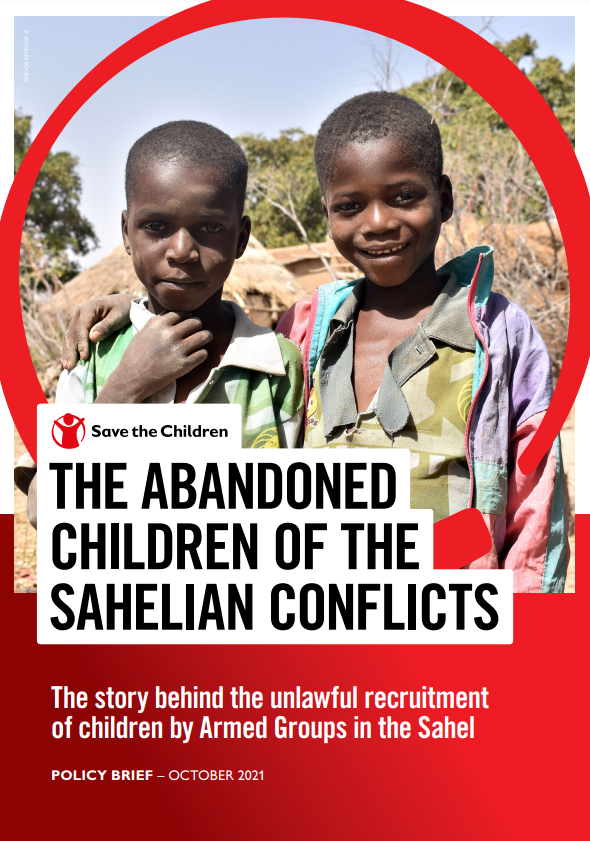
Reports
The Abandoned Children of the Sahelian Conflicts: The story behind the unlawful recruitment of children by armed groups in the Sahel
Publication year:
2021
English, French
Format:
PDF (2.6 MiB)
Publisher:
Save the Children International
With more than 1.4 million internally displaced persons in August 2021, rapid increasing violence and growing insecurity in the Central Sahel have led to a worsening security situation and an unprecedented humanitarian crisis. Such repeated violence seriously disrupts already fragile and hard-to-reach basic social services, such as education, protection and health. At the same time of publication, nearly 4,000 schools are still closed, due to the insecurity affecting 700,000 children in the 3 countries. At the same time, in 2020, it was estimated that 2.3 million children needed protection in the Sahel Central and that 8 out of 10 children were exposed to various forms of violence[1].
In this extremely fragile and volatile context, the recruitment of children by Non-State Armed Groups is emerging as a new phenomenon. Non-State Armed Groups are taking advantage of the continuing environmental degradation to recruit vulnerable children who are becoming the first victims of the ongoing conflicts in the Central Sahel. While it remains difficult to determine the exact number of children associated with Armed Groups/ Non-State Armed Groups, more and more children are being abducted, killed and maimed and recruited by Non-State Armed Groups. In 2020, according to the latest report of the UN Secretary-General on children and armed conflict, over 3 children victims of serious violations, 1 was in West and Central Africa. In Mali alone, according to official data, in 2019 more than 277 children were maimed or killed as a result of the conflict, this doubled the total in 2018. In the three-border region of Niger, “Armed Groups have already killed more than 60 children since the beginning of 2021”[2].
This new and growing phenomenon, which affects many children, has multiple causes. But in a region, where one in two people is under 15 years of age, this new phenomenon is worrying.
Recent data from the three countries converge and reflect a deliberate and clearly established strategy by Armed Group / Non-State Armed Groups. This strategy aims not only to undermine the presence and representation of the State , but also to take advantage of the frustrations and difficult conditions in which a large part of the young people of these countries grow to strengthen their base, through multiple and varied recruitment methods.
Behind the illusion offered to children and young people of having power and thus social recognition, in societies that offer them little future, reality is often less happy. Some children recruited by the AGs/NSAGs end up losing their illusions and manage to escape the control of Armed Groups. But they do not always get good follow-up. This lack of a mechanism for the care of young victims of AGs/NSAGs does not facilitate their social reintegration.
Although the situation in the Central Sahel is well known and recognised, the situation of these children is not considered sufficiently in current policies, particularly in conflict prevention and resolution strategies. Considering the specific needs of children, particularly in terms of protection and education, is no longer just a matter of respecting their rights. This is a central issue to help Central Sahel emerge from the crisis it is locked in!
The Central Sahel today faces an unprecedented challenge, and an important part of its response will lie in its ability to offer a better future to its youth. If they fail to offer solutions to this generation, these Central Sahel countries risk to bump into a wall with no way back.
[1] https://www.unicef.org/wca/fr/communiqu%C3%A9s-de-presse/23-millions-denfants-auront-besoin-de-protection-dans-la-r%C3%A9gion-du-sahel
[2] https://www.amnesty.org/en/latest/news/2021/09/niger-increasing-number-of-children-killed-and-recruited-by-armed-groups-in-sahels-tri-border-area-new-report/
Read full abstract
View & Download
Autodetected language
English
1 Documents
Other languages
French
1 Documents
Document information
Publisher
Format
Content type
Region
Rights
© Author/Publisher
Found a mistake? Help us improve!
If you have noticed a document assigned to the wrong author or any other inaccuracies, let us know! Your feedback helps us keep our data accurate and useful for everyone.
Share
Link

